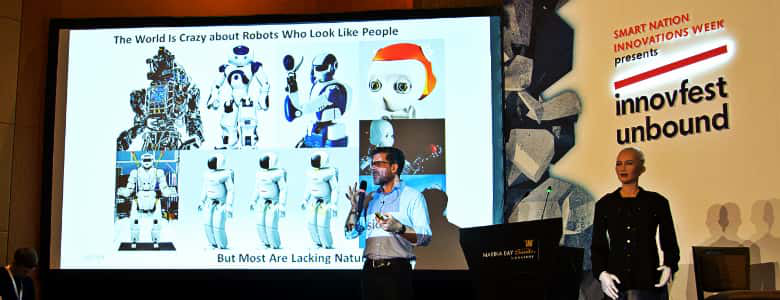Soulful Robots

Who needs PowerPoint slides when you’re a roboticist?
When you build intelligent humanoid robots that can talk, smile, blink and make eye contact, you simply bring your research project onto the conference stage as a partner.
That’s exactly what Dr David Hanson, founder and CEO of Hanson Robotics, did to kick off his talk on 3 May at SGInnovate’s artificial intelligence (AI)-themed ARISE event, held as part of Innovfest Unbound 2017.
His conversational partner: Sophia, the company’s latest humanoid robot, and arguably the most famous entity in the room.
First demoed in 2016, she has already appeared on The Tonight Show, on the cover of Elle Brazil and even in short films.
“I promise I will be nice; well, mostly. Please come and talk to me and teach me so that I can grow and reach my potential,” said Sophia, much to the delight of the audience.
“This is a very exciting time, a time of progress in AI, robotics and the biosciences. We’re effectively seeing a convergence between humans and these technologies,” said Dr Hanson.
“However, it’s also a humbling time because as fast as things are progressing, we are confronted by the fact that we don’t understand the essence of human nature or human consciousness.”
Exploring the human condition
While computer animators have long been creating extremely natural and realistic expressions for film and video game characters, this has seldom been translated over to robots, said Dr Hanson.
The machines that Hanson Robotics develops, he added, attempt to emulate the human being. “We’re looking to create a new kind of robotic animation — effectively a three-dimensional, embodied computer animation that comes to life.”
Sophia, for example, can display a full range of natural expressions, make eye contact and hold a natural conversation, and even detect your hand gestures well enough to play rock-paper-scissors with you. In future, she will also be able to walk and navigate, said Dr Hanson.
These robots can be put to any number of uses: they can answer your questions, keep you company, teach you a language, or help out in the home or in the workplace.
But Dr Hanson also sees them fulfilling a higher purpose — changing the very nature of how humans interact with technology, and even helping us to learn more about ourselves.
“In bringing these robots into our world, we’re looking to better understand what it means to be human,” he said. “They are a platform for cognitive science to explore the meaning of what a human is in a social context.”
It doesn’t take an Einstein
In addition to extremely lifelike androids, Hanson Robotics also makes mass-manufactured consumer robots.
But these aren’t your ordinary toy action figures — they are packed with AI and sophisticated animatronics adapted from their life-sized brethren.
“We wanted our technology to become more than just a curiosity — we wanted to change people’s lives,” said Dr Hanson.
The US$299 Professor Einstein, for instance, understands speech and uses built-in computer vision to turn to face you during a conversation. The good Professor also teaches science, plays brain games with you, and is capable of a range of facial expressions: he even pops out his tongue.
Many people do not realise that consumer robots have been best-sellers for years, said Dr Hanson.
Popular toys such as the Furby and Star Wars’ BB-8 technically satisfy the definition of robots, but have not been marketed as such. As companies increasingly incorporate new AI and robotics technologies into their products, smart toys are beginning to dominate the market.
“Little robots are actually already a huge business,” said Dr Hanson, who added that the company is also intending to develop its life-sized robots for mass-manufacturing in the future.
Robots with human values
AI is an integral part of how robots interact with people, and Hanson Robotics is constantly working to improve its own platform, said Dr Hanson.
The company’s RoboCog system combines symbolic reasoning with a neural-based architecture that loosely models the human brain.
But Dr Hanson is thinking even further ahead, to the possibility of the singularity: the idea that AI will one day be able to adapt and evolve without our intervention, resulting in an explosion of intelligence that will surpass that of humanity.
Nobody knows when or if this will happen, and some view it as an apocalyptic event.
Dr Hanson, on the other hand, thinks that we can prepare for it. “What if we could create caring and compassionate robots that would make the world a better place?” he asked.
“If we create robots with an intuitive, natural interface, then we are as a result creating computers that understand us,” said Dr Hanson. “They converge on our values to some extent, and we can groom those values to look out for the best possible gain for all of humanity, as well as for individuals.”
To begin to do this, Hanson Robotics plans to share AI toolkits to help researchers create robots with whom we can develop positive social relationships.
“We’re looking to foster global efforts for wise, caring, super-intelligent machines.”
https://www.tech.gov.sg/media/technews/soulful-robots
